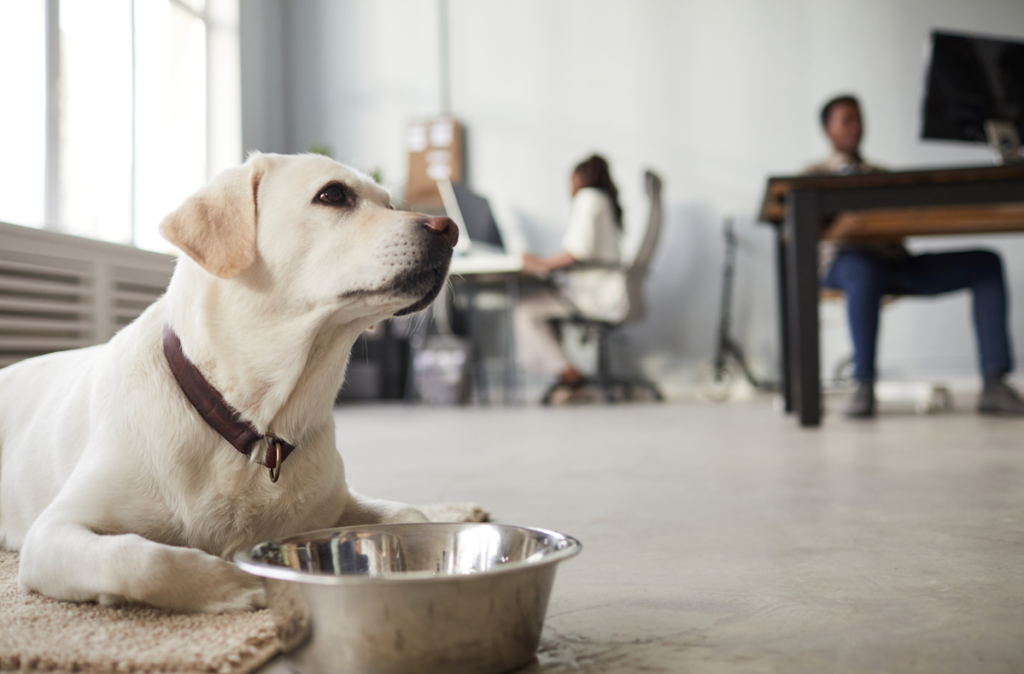The Pet-Friendly Coworking Space: Opportunities, Risks, and Practical Tips for Operators
In recent years, the coworking concept has evolved at a rapid pace. It’s no longer just freelancers or startups reaping the benefits of shared offices; increasingly, larger companies, project teams, and digital nomads are also getting on board. Alongside the trend toward more openness to flexible work models, there is a growing demand for work environments that are not only functional but also more personal and calming. Many coworking spaces are therefore focusing on a special unique selling point: being pet-friendly. Dogs are often the first animals that come to mind when thinking about workplace companions. Yet, this decision brings both advantages and challenges.
In this blog post, we take a detailed look at the pros and cons of pet-friendly coworking spaces and offer operators helpful tips on how to bridge the gap between animal-loving members and those who may be less comfortable with pets.

Why Offer a Pet-Friendly Coworking Space?
The concept of a dog-friendly – or generally pet-friendly – work environment is no longer just a niche topic. Numerous studies and practical reports indicate that having animals in the workplace can improve the overall work atmosphere. Animals often project a sense of calm, balance, and cheerfulness that can quickly spread to those around them. In turn, this boosts creativity, reduces stress, and can even increase productivity. Especially in coworking spaces, where individuals from a wide range of industries often come together, a welcoming, pet-friendly environment can help break down barriers and foster communication.
Moreover, pet-friendly policies in coworking spaces capture the attention of many potential clients. In an increasingly competitive market, such policies can serve as a significant unique selling point. Anyone looking to stand out from the crowd and build a truly special community of like-minded professionals and animal lovers may naturally consider allowing dogs or other four-legged companions.
The Benefits of a Pet-Friendly Coworking Space
Pet-friendly coworking spaces appeal to many members and prospects with a variety of advantages:
- Stress Reduction and Well-Being: The presence of dogs or cats can lower cortisol levels and improve mood. Especially during intense work phases, many people find short breaks with a pet to be a “mini timeout.”
- Higher Productivity: Feeling more comfortable in the workplace often leads to increased motivation and creativity. This can have a positive impact on overall work performance and satisfaction.
- Community and Networking: Sharing time with animals creates instant conversation topics and fosters a sense of community. Casual chats during feeding or walking the dog strengthen group cohesion and make it easier to get to know one another.
- A Unique Selling Point (USP): A pet-friendly orientation can serve as a distinguishing factor in the local market, especially if there are many similar coworking spaces nearby. This can be the deciding factor in attracting new members.
Finally, dog owners who might otherwise leave their pets at home experience significant relief. They save on pet-sitting costs, can take walks during breaks, and don’t have to worry if the workday stretches longer than expected.
The Challenges of a Pet-Friendly Coworking Space
Despite all the benefits, there are, of course, aspects that operators and users should keep in mind:
- Allergies and Fears: Not everyone feels safe and relaxed around animals. People with allergies or phobias may feel disturbed or even threatened.
- Noise and Hygiene: Dogs, in particular, may bark when stressed or occasionally relieve themselves indoors if not properly supervised. This can lead to annoyance among other members.
- Conflicts Between Animals: When multiple pets are present at the same time, conflicts can arise. Inexperienced dog owners or unsocialized animals can increase the potential for disputes.
- Liability Issues: What happens if the animal causes damage or even injures someone? Questions about insurance and liability need to be clarified in advance.
Operators should therefore address these challenges and set up the necessary guidelines to ensure a smooth experience for everyone.
Tips for Operators: How to Successfully Implement a Pet-Friendly Concept
If you want to successfully create a pet-friendly coworking space, you’ll need a clear concept and proactive organization. Here are some key recommendations:
- Establish Clear Rules
For instance, specify which animals are allowed (e.g., only dogs, cats, rabbits), whether they must be vaccinated and microchipped, and what behavior standards are acceptable (such as not using office areas as a permanent “dog park”). Having written guidelines for pets creates clarity. - Define Capacity Limits
Having too many animals at once can quickly lead to unrest and conflicts. Set a maximum number of animals per day or per unit of space to ensure a balanced environment for everyone. - Find Spatial Solutions
Separate retreat areas for animals and designated pet-free zones increase safety and reduce potential disturbances. Special “dog lounges” equipped with bowls and cushions, or enclosed rest areas, often work very well. - Give Preference to Experienced Dog Owners
When someone is caring for their first dog and has little experience, problems may arise. Conduct conversations in advance, inquire about training experience, and if necessary, recommend dog training before the animal regularly joins the coworking space. - Have an Emergency Plan and Safety Concept
Decide what should happen if something goes wrong; be it a dog bite, an allergic reaction, or a runaway pet. Inform all members about emergency contacts and insurance details.

Communication and Community Management
Introducing pet-friendly rules in a coworking space requires effective communication. Many operators underestimate the wide range of opinions among members. Some love animals, while others prefer no contact or are simply concerned about cleanliness and the work atmosphere. Therefore, it’s advisable to:
- Conduct a Survey: Before opening your space to animals, collect feedback from current members. This allows you to identify potential concerns early on and gives you the chance to find constructive solutions.
- Host Workshops or Info Sessions: Hold a brief presentation or workshop to address questions, offer tips for handling dogs, and clarify everyone’s perspective. This helps increase community acceptance.
- Regular Evaluation: Carry out frequent check-ins to see how the atmosphere is developing. Ask both pet owners and non-pet owners whether any adjustments are necessary.
Practical Examples
An increasing number of coworking spaces are already successfully putting this concept into action. In various cities, some spaces designate specific days as “Dog Days” to keep the number of animals manageable and give members time to prepare. Others offer special “Pet-Friendly” memberships, where owners pay a small additional fee, often to cover cleaning costs. Many spaces even provide dedicated comfort zones, complete with food and water bowls, toys, and cozy sleeping areas. Such offerings are often perceived as a community bonus and help strengthen members’ loyalty to the space.
Conclusion: Weigh, Organize, and Profit
Deciding to operate a pet-friendly coworking space isn’t straightforward. There are clear advantages, such as a stronger sense of community, satisfied members, and a unique selling point in a competitive market. On the other hand, risks include potential conflicts, hygiene issues, and the challenge of keeping all members equally happy. However, those who implement this concept thoughtfully, with clear rules and transparent communication, can reap significant rewards from the positive atmosphere and distinctiveness a pet-friendly space provides.

